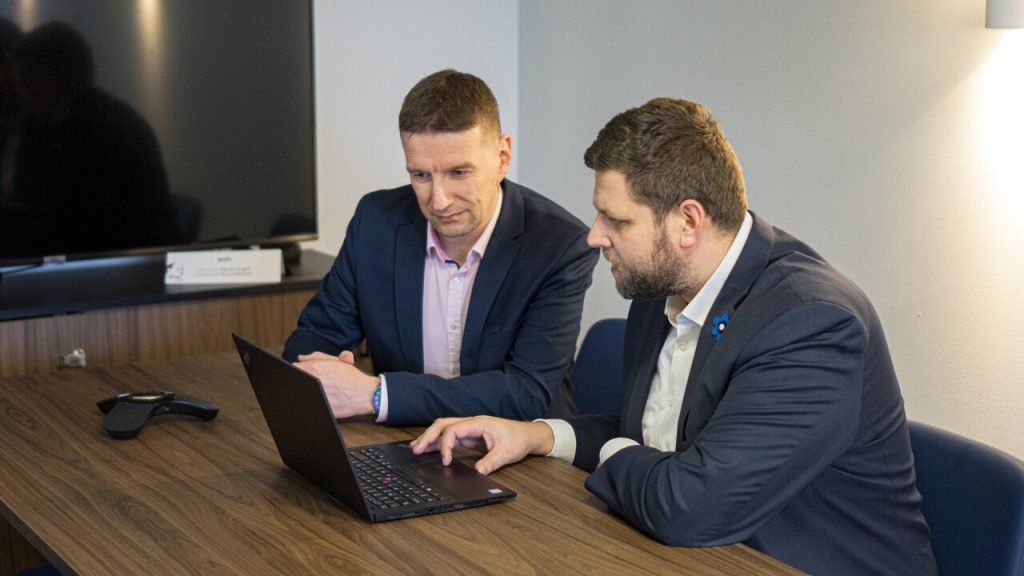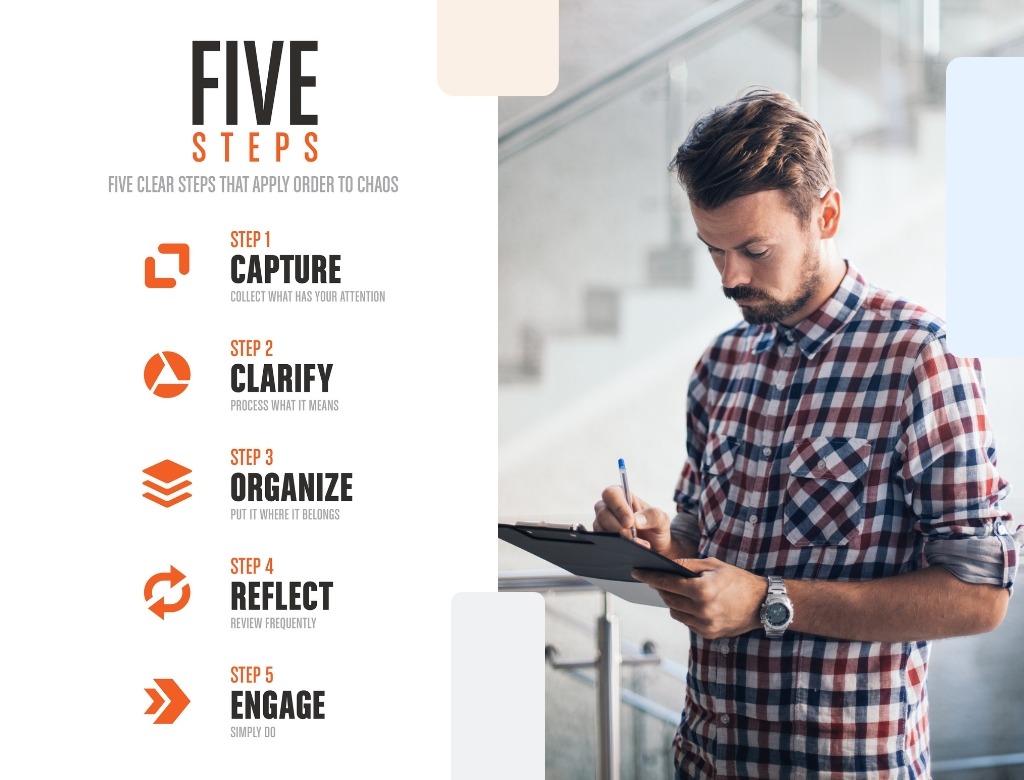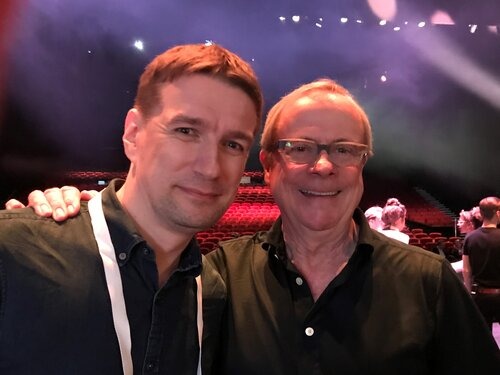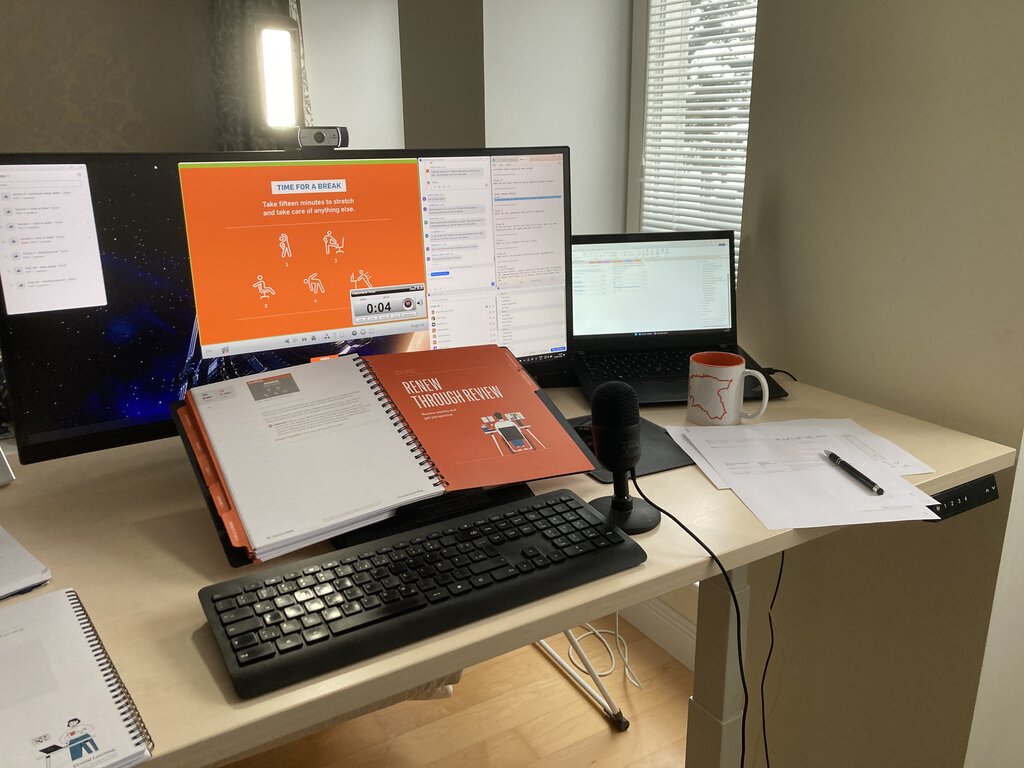how to be a stress-free and productive e-resident
The enduring application of the Getting Things Done methodology and how it can support e-resident entrepreneurs

I still have my 2005 paperback edition of David Allen’s Getting Things Done book, and remember vividly its effect on me, as a multitasking employee-preneur with a young family.
I had been devouring productivity literature for years, but everything that went before seemed so high level, so top-down. All excellent in principle, but how the heck was I supposed to figure out my big life purpose and goals, when I had all this endlessly expanding stuff to stay on top of day after day? Getting Things Done (GTD) was the first framework I had come across which both acknowledged the emotional and intellectual energy drain created by all that stuff, and helped me to deal with it from the ground up.
It’s no different for today’s typical multitasking plate-spinning e-resident. We exist in a world of constant noise and notifications and infinite information. Managing our attention has never been more critical, and achieving David Allen’s ‘mind like water’ (a calm state of readiness that cannot over nor underact to any stimulus) can easily seem further away than ever… Because we have so many more ‘things’, occupying what Allen referred to as our psychic RAM.
Honestly, GTD changed my life. And it has the potential to change yours!
Even if (like me) you never feel 100% black-belt on top of everything, simply getting closer to the calm it creates frees up creativity and energy and potential, to take your business to the next level.
Two decades, and many hundreds of to-do apps and planners later, I still use the essentials of method every day. It’s deceptively simple, technology-agnostic (it started as lists and pieces of paper), and universally applicable.
How to get things done
It’s all about 5 easy steps…
- Capture - everything on your mind, or that should be. Gather it up into some kind of list or pile
- Clarify - work through and decide whether each item in the list is actionable, or needs some other treatment
- Organise - get those next actions sorted out so the reminders and prompts will show up when it’s time to do each thing
- Reflect - review all the systems and lists regularly, so they’re current, and you trust them implicitly
- Engage - then, do the next thing. Apply total focus, because your mind is clear.
At its heart, GTD recognises that each of us has a whole bunch of inputs tugging at our attention, from ideas to questions to commitments to specific things we need to achieve. The first step is to gather up in one place, so our brains can ‘let go’ of its need to continually hang on to them. The hanging on creates stress, and degrades our ability to focus and create. But our brain will only cooperate with this strategy, if it trusts that all the things are captured somewhere safe where they won’t get lost or forgotten.
The second step, to be performed regularly, is to clarify what each item really is, and what you need to do about it. You cannot do an idea, or a project, or a goal. You can only do the next action that will take you towards resolving a desired outcome. And some inputs have no doable outcome, but need to be parked or incubated for now.
That might be a 5-minute single action, to reply to that email or google that recipe. But more often than not, you have a complex, multi-stage project on your hands. It might also be something to hand off to someone else, to file for reference, or to delete and forget about. But once you figure that out, you’ll have things grouped into projects, and the next action needed to move each project forward.
After that, you’ll be able to prioritise and contextualise and actually do the things, with more confidence that the thing you are doing currently, is the best way to be spending your time right now.
Once you know that, your focus will be free to move up above that ground level, and enable you to get clear what a ‘done’ project will look like. Then you can focus on your areas of responsibility, your bigger goals, and your purpose - but all that is for once you’ve cleared all your inboxes (on every app, device, and the one in your brain.)

There’s more to the method of course, but its enduring simplicity and universality has led the David Allen Company to global success, and an almost cult-like web of adherents now spanning generations.
And it’s perfect for modern knowledge-work entrepreneurs, whose flood of inputs is potentially infinite, and for whom focus has never been a more crucial competitive differentiator.
How to get things done in Estonia
Today, the method is taught and supported by a network of franchisee trainers and coaches, bringing GTD to individuals and teams worldwide - people like Estonia’s Paul Vahur, Certified GTD trainer, and Founder of GTD Estonia (Brightwork OÜ.)
Paul is of course another GTD veteran, who joined the cult at an early age, and found its principles vitally useful when he worked at Microsoft in 2013, first as an employee and then as a contractor. In common with many Estonians with entrepreneurialism in their DNA, he also founded a startup helping foreigners to set up businesses in Estonia, before e-Residency made that so much easier.
Like so many entrepreneurs, he found that he thrived on the complexity, the variety, and diversity of tasks that a blend of contract work, startup life, and work with clients demanded. But to maintain a clear mind and a strategic oversight of all his commitments and ideas, it was essential to stay across the thousands of details systematically, without losing perspective on the bigger picture.
His secret weapon was always GTD - or should I say not so secret, as he admits he was always telling everyone about it. Like almost everyone, Paul learned the method initially from the book, and found everything he needed there to impact his life by transforming his personal productivity.
However in 2019, the David Allen Company had a summit in Amsterdam, and for Paul, that was the encouragement he needed, to take things to the next level.

“It was a really great experience. I met David Allen, and got my photo with my signed book. But I also connected with the business network, and I met franchisees.”
The deceptive simplicity of the GTD method has spawned dozens of apps and other tools over the years.
But the David Allen Company has protected its essential IP by licencing its coaching and training offering through a global network of experts.
And at the time in 2019 there was a vacancy in the territory of Estonia…
“It was a moment of truth,” admitted Paul, who was actively opening his mind to his next business venture at that time. He instantly saw the opportunity to combine his passion for GTD with his desire to help others achieve the celebrated ‘mind like water,’ of a bulletproof productivity system. (Allen is a big martial arts devotee, and it’s this zen-like state of calm readiness to which we should all aspire.)
“There was a licence fee that I had to pay up front, and I knew that it would be tough at first to build up the business, even to be able to deliver the training.”
He signed the contract in February 2020, and like the rest of the world, had no idea how things were about to change. The GTD training format as licenced then was primarily designed around in-person delivery, but as Paul explained, “within two weeks they had finalised an online version.”
For a global network, this one fact blew me away - transforming their product to online delivery at such speed, could surely only happen in an organisation that was completely current, connected, and aligned, with everything already systematised. Remember what those weeks were like then… from enterprises to governments to public sector organisations, around the world chaos reigned, markets crashed, and leadership floundered.
But the David Allen Co, much like the Estonian Government, just rolled with it and maintained business as usual.
“That’s David Allen level foresight!” Paul reflected. “He’s always said you need to be ready for anything, for something you don’t see coming, that could turn your world upside down. He even said it - not for the first time - on a video in March 2020.”
"...you need to be ready for anything, for something you don’t see coming, that could turn your world upside down..."
So Paul became a certified GTD trainer in 2020, and started to deliver the training in its new format. Since then, he has introduced GTD and delivered training to hundreds of participants across many organisations in Estonia, online and in person, including Microsoft, Playtech, ABB, Veriff, Janssen Baltics, Helmes, TREV-2, and Lift99,
But his true goal was to become a GTD coach, and deliver one-to-one support to those who had the scope to transform the way entire organisations worked and achieved their goals.
“The coaching is priced, and aimed at, leadership and top specialists. Of course, it’s open to everyone, but it’s not as accessible to most people,” he clarified. Change in organisational culture needs to come from the c-suite, and this is as true about personal productivity as anything else.
Last year, 2023, Paul concluded the process, and certified as GTD Coach. “I had to qualify and complete the training, including 7 practice coaching sessions. The full programme is a two-day session, to help them develop the habits and tackle all their commitments, but there are also shorter one-day and even half-day options.”

Changing the way leaders and entrepreneurs get things done
His business now mainly targets the coaching clients, because to change the way a team or a whole enterprise works, it’s essential to get that buy-in. “I still provide training as well,” Paul explained, and indeed he is actively engaged now in translating all the official training content into Estonian, to broaden his market and accessibility. “But if I coach the head of the company, and they see the value in that, then it can lead to training everyone.”
And it’s the leaders, at every level, who have most in common with typical entrepreneurial e-residents.
Dealing with complexity. Dealing with change. Integrating new technologies and challenges. Not having someone else’s framework or system to implement, but having the freedom to create their own. Continually treading the fine line between creative freedom and overwhelm is the price of designing your own business and lifestyle… and let’s face it, most of us wouldn’t have it any other way! But that very lack of guardrails often leads to vertigo, and overwhelm. What should I do next in my business today?
"...treading the fine line between creative freedom and overwhelm is the price of designing your own business and lifestyle... and let's face it, most of us wouldn't have it any other way!"
Apply for e-Residency
Taking GTD into the future
My battered and yellowing paperback has been reissued and updated several times, and the most recent editions make fewer references to labelling machines, Palm pilots and Lotus Notes. But even though there is - excitingly - a new book coming out later this year about team implementations, GTD remains at its heart a self-management system, and that has not changed. It recognises that the only person who can manage your own stuff is you. That commitment to yourself and others makes you who you are.
You can find a million apps to suit your preferences, incidentally, and almost any ‘to-do list’ type tool can serve as your GTD hub. So long as it has some basic hierarchy of actions within projects, and that you can further tag them with some metadata or context. The point is to avoid getting hung up on the system and maintaining/perfecting it, or wondering whether you should migrate everything to next shiny AI-augmented whatever-it-is. Allen started it all with paper lists within carefully labelled folders!
You already have everything you need, in terms of gear, if you have a smartphone with some kind of lists app and reminder functionality.
The promise of stress-free productivity remains as enticing as ever, and still far unreachable for so many in 2024. I cannot tell you that a ‘mind like water’ is easy to achieve, nor that this does not take constant work.
But the basics are simple enough. Capture all the open loops, figure out what to do with them, and organise them into lists and projects that will get back into your attention when the time is right. Then do the things you need to do.
I highly recommend reading the book to start with, and then think about investing some training or even coaching with Paul through your Estonian business, to help you unlock the true power of Getting Things Done.
More from e-Residency
- Sign up for our newsletter
- Watch fresh video content - subscribe to our Youtube channel
- Meet our team and e-residents - register for our next Live Q&A